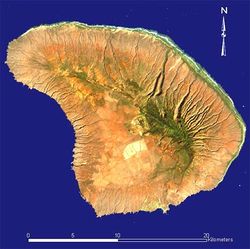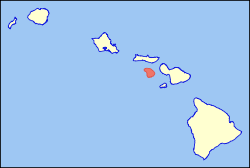Lanai
| Lānaʻi | |
|---|---|
| The Pineapple Isle | |
 Landsat satellite image of Lānaʻi. |
|
 Location in the state of Hawaiʻi. |
|
| Geography | |
| Area | 140.5 sq mi (364 km2) |
| Rank | 6th largest Hawaiian Island |
| Highest point | Lānaʻihale |
| Max elevation | 3,366 ft (1,026 m)[1] |
| Demographics | |
| Population | 3,193 (as of 2000) |
| Density | 23/sq. mi. (9/km²) |
| Official Insignia | |
| Flower | Kaunaʻoa (Cuscuta sandwichiana) |
| Color | ʻĀlani (orange) |
Lānaʻi or Lanai (pronounced /ləˈnaɪ/ in English and or [laːˈnɐʔi] in Hawaiian) is the sixth-largest of the Hawaiian Islands. It is also known as the Pineapple Island because of its past as an island-wide pineapple plantation. The only town is Lānaʻi City, a small settlement. The island is somewhat comma-shaped, with a width of 18 miles (29 km) in the longest direction. The land area is 140.5 square miles (364 km2), making it the 42nd largest island in the United States.[2] It is separated from the island of Molokaʻi by the Kalohi Channel to the north, and from Maui by the ʻAuʻau Channel to the east. The United States Census Bureau defines Lānaʻi as Census Tract 316 of Maui County. Its total population was 3,193 as of the 2000 census.[3] Many of the island's landmarks and sites are located off dirt roads where four-wheel drive is required.
Contents |
History
Lānaʻi has been under the control of nearby Maui since before recorded history. The first inhabitants of this island may have arrived as late as the 15th century. According to the Hawaiian legends, man-eating spirits occupied the island before that time. For generations, Maui chiefs believed in these man-eating spirits. Depending on which legend one follows either the prophet Lanikāula drove the spirits from the island or the unruly Maui prince Kauluāʻau accomplished that heroic feat. The more popular myth is that the mischievous Kauluāʻau pulled up every ʻulu (Artocarpus altilis) tree he could find on Maui. Finally his father, Kakaʻalaneo had to banish him to Lānaʻi, expecting him not to survive in that hostile place. However Kauluāʻau was able to outwit the spirits and drive them from the island. The chief looked across the channel from Maui and saw that his son's fire continued to burn nightly on the shore, and he sent a canoe to Lānaʻi to bring the prince, redeemed by his courage and his cleverness, back home to Maui. As a reward, Kauluāʻau was given control of the island and he encouraged immigration from other islands.[4] True to himself Kauluāʻau had, in the meantime, pulled up all the ʻulu trees on Lānaʻi, accounting for the lack of ʻulu on that island. The name Lānaʻi is of uncertain origin, but the island has historically been called Lānaʻi o Kauluāʻau. One theory is that the phrase means "day of the conquest of Kauluāʻau."
The first people to migrate here, most likely from Maui and Molokaʻi, probably established fishing villages along the coast initially but later branched out into the interior where they raised taro in the fertile volcanic soil. During most of those times, the Moʻi of Maui held dominion over Lānaʻi. Even today, Lānaʻi is part of the County of Maui, but apparently the Maui leaders primarily left the people of Lānaʻi to their own devices. Life on Lānaʻi remained relatively calm until King Kamehameha I or Kalaniʻōpuʻu-a-Kaiamamao came over to take control, slaughtering people on every part of the island. So many were killed that when Captain George Vancouver sailed past the island in 1792, he didn't bother to land because of Lānaʻi's apparent lack of villages and population. It is mentioned that Lānaʻi was the favorite fishing spot of Kamehameha out of all the eight islands.
Lānai was first seen by Europeans on February 25, 1779, when Captain Charles Clerke sighted the island from aboard James Cook's HMS Resolution. Clerke had taken command of the ship after Cook was killed at Kealakekua Bay on February 14 and was leaving the islands for the North Pacific.
In 1922, James Dole, the president of Hawaiian Pineapple Company (later renamed Dole Food Company), bought the entire island of Lānaʻi and developed a large portion of it into the world's largest pineapple plantation.
In 1985, Lānaʻi passed into the control of David H. Murdock, as a result of his purchase of Castle & Cooke.
Tourism
Tourism on Lānaʻi started more recently as the pineapple industry was phased out in the islands.
There are two resort hotels on Lānaʻi, both managed by Four Seasons Hotels and home to a golf course: Mānele Bay and the Lodge at Kōʻele. The latter is unusual for a resort in Hawaiʻi in that it is located inland rather than near the beach. In addition, in Lanai City, there is the Hotel Lānaʻi which was built in 1923 by James Dole of the Hawaiian Pineapple Company as a lodge to house the executives overseeing the island’s pineapple production. It was the island’s only hotel until 1990.
In Lanai City, there are no traffic lights, no shopping malls, and no public transportation. Most of the attractions on the island outside of the hotels and town can be visited only via dirt roads that require a four-wheel drive vehicle.
Gallery
 View of a former Lānaʻi pineapple field, now a field of grass |
 View of some local houses in Lānaʻi City |
 View of Garden of the Gods |
 Garden of the Gods (another view) |
 Mountains on Lānaʻi |
Shipwreck Beach sign |
 View of East Molokaʻi from Shipwreck Beach, Lānaʻi. |
 View of the shipwreck at Shipwreck Beach |
 The Stables at Kōʻele |
 Hotel Lānaʻi |
.jpg) Hole 17 at the Experience at Kōʻele golf course |
 The Lodge at Kōʻele |
References
- ↑ "Table 5.11 - Elevations of Major Summits". 2004 State of Hawaii Data Book. State of Hawaii. 2004. http://www.hawaii.gov/dbedt/info/economic/databook/db2004/section05.pdf. Retrieved 2007-07-23.
- ↑ "Table 5.08 - Land Area of Islands: 2000". 2004 State of Hawaii Data Book. State of Hawaii. 2004. http://www.hawaii.gov/dbedt/info/economic/databook/db2004/section05.pdf. Retrieved 2007-07-23.
- ↑ Census Tract 316, Maui County United States Census Bureau
- ↑ Let's Go Hawaii: On a Budget By Inc. Let's Go, Sara Joy Culver, Let's Go Inc. Page 350
External links
- "Chapter 6: Lānaʻi". Hawaii’s Comprehensive Wildlife Conservation Strategy. State of Hawaiʻi. 2005-10-01. http://www.state.hi.us/dlnr/dofaw/cwcs/files/NAAT%20final%20CWCS/Chapters/CHAPTER%206%20lanai%20NAAT%20final%20!.pdf.
|
||||||||||||||||||||
|
||||||||||||||||
